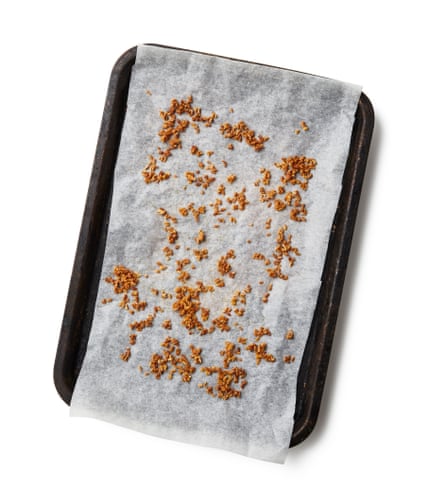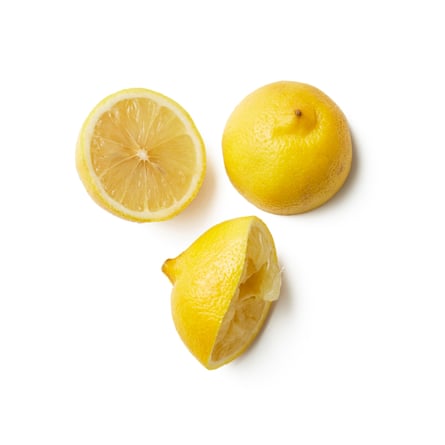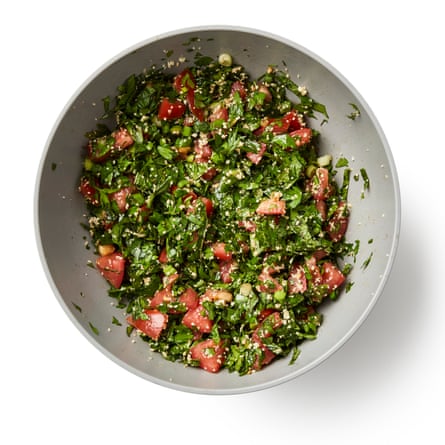Let’s get one thing straight from the start: tabbouleh is not the bulgur wheat salad with a sprinkling of herbs that is often served under the name outside its Levantine birthplace. Rather, it is a parsley salad with a sprinkling of grains – all verdant and glossy with oil – and the ideal fresh, peppery accompaniment to richer meze such as hummus and salted cheese, or grilled meat and fish.
Prep 30 min
Cook 20 min
Serves 4
15g medium bulgur wheat (optional)
30g fine bulgur wheat
400g ripe tomatoes
6 spring onions
2 lemons
½ tsp ground black pepper
½ tsp ground allspice
½ tsp ground cinnamon
½ tsp ground coriander
¼ tsp ground nutmeg
¼ tsp ground cloves
¼ tsp ground ginger
175g flat-leaf parsley
45g bunch mint
80ml extra-virgin olive oil, plus extra for greasing
Salt
2 tbsp pomegranate seeds (AKA arils), optional
Cos or little gem lettuce, to serve, optional
1 Rinse, drain and toast the medium bulgur

Traditionally, tabbouleh is made with fine bulgur wheat, but I like to add some crunch in the form of some toasted coarser grains. If that appeals, heat the oven to 160C (140C fan)/310F/gas 2½, put the medium bulgur in a sieve, rinse with boiling water, then drain well. Spread out on a lightly greased oven tray and bake for 20 minutes.
2 Rinse, drain and fluff the fine bulgur

Meanwhile, put the fine bulgur in a sieve, rinse under cold running water until it runs clear, then drain well – it’s important to spend time on this, or your salad will be soggy. Tip into a bowl and fluff up with a fork. Once the medium bulgur is toasted, if you’re using it, fluff that up similarly and put to one side.
3 Add the tomatoes and spring onions

Put the fine bulgur in a salad bowl. Cut the tomatoes into smallish dice, retaining all the juices, and trim and finely slice the spring onions, using most of the green parts as well as the white bases. Add both, plus the juices from the tomatoes, to the bowl and mix briefly.
4 Squeeze in the lemons

Roll the lemons across a hard surface (or microwave them for 10 seconds) – this helps them release their juices – then cut in half and squeeze three of the halves directly into the bulgur bowl, taking care not to let any pips slip in there, too, because they’re hard to retrieve and bitter to crunch down on (a small sieve is helpful here).
5 Mix the spices

Mix all the spices in a small bowl, and add a teaspoon’s-worth to the bulgur bowl. This mix is based on the classic Lebanese seven-spice blend, which you could use instead, if you come across it; if you prefer a more savoury flavour, substitute baharat, the generic Arabic term for spice (the versions most commonly sold in this country tend to be more cumin-heavy).
6 Wash and dry the herbs
Douse the parsley and mint in cold water, shake well to dry, then gently roll them in a clean tea towel to absorb any remaining moisture. Remove and discard most of the stalks from the parsley, unless they’re very young and tender.
7 Slice the parsley

Take a small bunch of the parsley, gather it tightly on a board, and slice as finely as you can. Don’t be tempted to chop – we’re making a salad, here, not a pesto. (And don’t use a food processor – it will turn the herbs to mush!) Put the sliced parsley in the bowl and repeat with the remaining parsley. Take your time because it is the star ingredient.
8 Now for the mint
Pick the leaves off the mint sprigs and slice in the same way as the parsley, though this time being as gentle as possible, because mint bruises and wilts very easily. Add to the bowl with the oil and a pinch of salt, toss well and taste. Add more salt, lemon juice or spice as required.
9 Finishing touches

Scatter the pomegranate and toasted bulgur wheat, if using, all over the top only just before serving – I love the sweetness that the seeds bring to the dish, though, like the toasted bulgur, they’re not traditional. Serve with or without lettuce leaves to scoop up the salad, as part of a meze selection, as a side dish or with flatbread for a light lunch.
